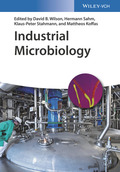Industrial Microbiology

1. Edition January 2020
XX, 398 Pages, Softcover
56 tables
Textbook
Short Description
First-hand knowledge about a booming field in the applied life sciences, for students and junior professionals in biotechnology, bioengineering, biochemistry and microbiology.
Teaches everything about industrial microbiology - from the fundamentals to the current state of the art to future prospects
This book brings together the insight and expertise of leading researchers and professionals from across the field of industrial microbiology to give students a handy, practice-oriented text that showcases the industry and the future potential of microbes for industrial processes. After a brief introduction to the technology of microbial processes, the twelve most important application areas for microbial technology are described, from crude bulk chemicals to highly refined biomolecules such as enzymes and antibodies, to the use of microbes in the leaching of minerals and for the treatment of municipal and industrial waste.
Aimed at students of biotechnology, bioengineering, microbiology, and related disciplines, Industrial Microbiology starts with a historic overview of the subject, as well as future perspectives on it. It then goes on to offer in-depth chapter coverage of topics such as: bioprocess engineering; food; industrial alcohols and ketones; organic acids; amino acids; vitamins, nucleotides, and carotenoids; and antibiotics and pharmacologically active compounds. There are also sections on pharmaceutical proteins; enzymes; polysaccharides; steroids; bioleaching; and wastewater treatment processes.
- Offers a modern approach to a key field in applied science
- Focuses on current and future uses of microbes as production organisms, complementing traditional textbooks of microbiology and biotechnology
- Presents an application-oriented account of the topic, focusing on the translation of basic research into industrial processes while citing numerous successful examples
- Written by experts working or collaborating in industrial operations within the field
- Filled with case studies and examples
Filled with practical, user-friendly material, Industrial Microbiology is an excellent, accessible text for students of microbiology, biotechnology, biochemistry, bioengineering, and life sciences.
Use of fermentation procedures prior to the discovery of microorganisms (Neolithic Era = New Stone Age until 1850)
Investigation of microorganisms and beginning of industrial microbiology (1850 until 1940)
Development of new products and processes: antibiotics and other biomolecules (after 1940)
Genetic engineering as successful tool for industrial microorganisms (after 1980)
Future perspectives: Synthetic microbiology
BIOPROCESS ENGINEERING
Introduction
Non-structured models
Oxygen transport
Heat generating aerobic processes
Product recovery
Modeling and simulation of reactor behavior
Scale-up
FOOD
Fermented foods
Microorganisms and metabolism
Yeast fermentations - Industrial application of Saccharomyces species
Vinegar - Incomplete ethanol oxidation by acetic acid bacteria such as Gluconobacter oxidans
Bacterial and mixed fermentations- Industrial application of lactic acid bacteria, with or without yeast or molds
Fungi as food
Conclusions and outlook
INDUSTRIAL ALCOHOLS AND KETONES
Introduction
Ethanol synthesis by Saccharomyces cerevisiae and Clostridium autoethanogenum
1,3-Propanediol synthesis by Escherichia coli
Butanol and isobutanol synthesis by clostridia and yeast
Acetone synthesis by solventogenic clostridia
Outlook
ORGANIC ACIDS
Introduction
Citric acid
Lactic acid
Gluconic acid
Succinic acid
Itaconic acid
Downstream options for organic acids
Perspectives
AMINO ACIDS
Introduction
Production of amino acids
L-Glutamate synthesis by Corynebacterium glutamicum
L-Lysine
L-Threonine synthesis by Escherichia coli
L-Phenylalanine
Outlook
VITAMINS, NUCLEOTIDES, CAROTENOIDS
Application and economic impact
L-Ascorbic acid (vitamin C)
Riboflavin (vitamin B2)
Cobalamin (vitamin B12)
Purine nucleotides
ß-Carotene
Perspectives
ANTIBIOTICS AND PHARMACOLOGICALLY ACTIVE COMPOUNDS
Microbial substances active against infectious disease agents or affecting human cells
beta-Lactams
Lipopeptides
Macrolides
Tetracyclines
Aminoglycosides
Claviceps alkaloids
Perspectives
PHARMACEUTICAL PROTEINS
History, main areas of application and economic importance
Industrial expression systems, cultivation and protein isolation and legal framework
Insulins
Somatropin
Interferons ? Application and manufacturing
Human granulocyte colony-stimulating factor
Vaccines
Antibody fragments
Enzymes
Peptides
View - Future economic importance
ENZYMES
Fields of application and economic impacts
Enzyme discovery and improvement
Production process for bacterial or fungal enzymes
Polysaccharide-hydrolyzing enzymes
Enzymes used as cleaning agents
Feed supplements - phytases
Enzymes for chemical and pharmaceutical industry
Enzymes as highly selective tools for research and diagnostics
Perspectives
MICROBIAL POLYSACCHARIDES
Introduction
Heteropolysaccharides
Homopolysaccharides
Perspectives
STEROIDS
Fields of applications and economic importance
Advantages of biotransformations during production of steroids
Development of production strains and production processes
Applied types of biotransformation
Synthesis of steroids in organic-aqueous biphasic systems
Side chain degradation at phytosterols by Mycobacterium to gain steroid intermediates
Biotransformation of cholesterol to gain key steroid intermediates
11-Hydroxylation by fungi during synthesis of corticosteroids
delta1-dehydrogenation by Arthrobacter for the production of prednisolone
17-keto reduction by Saccharomyces in testosterone production
Double bond isomerization of steroids
Perspectives
BIOLEACHING
Mineral-oxidizing acidophilic bacteria dissolve metals from sulfide ores
Bioleaching of copper, nickel, zinc and cobalt
Gold
Uranium
Perspectives
WASTEWATER TREATMENT PROCESSES
Introduction
Biological treatments for carbon, nitrogen and phosphorus removal
Wastewater treatment processes
Advanced wastewater treatment
Future perspectives
Hermann Sahm, PhD, is Emeritus Professor of Biotechnology at the University of Düsseldorf (Germany).
Peter Stahmann, PhD, is Professor for Technical Microbiology at Brandenburg University of Technology Cottbus-Senftenberg in Senftenberg (Germany).
Mattheos Koffas, PhD, is Professor of Biology at Rensselaer Polytechnic Institute in Troy (USA).


